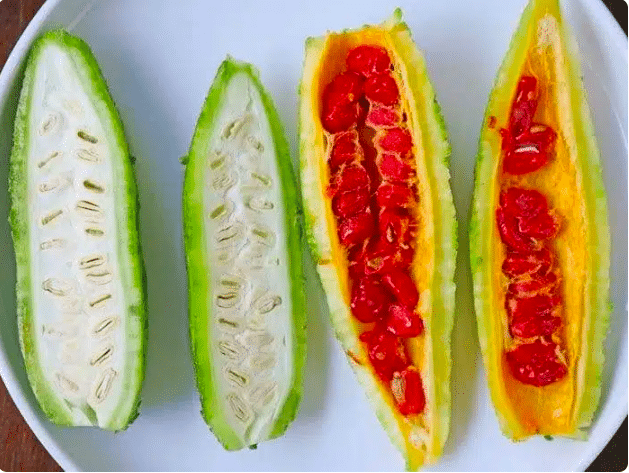Bitter melon, also known as bitter gourd or Momordica charantia, is a tropical and subtropical vine that not only adds a unique flavor to your culinary experience but also offers a host of health benefits. Whether you have a small garden or a cozy balcony, growing bitter melon in containers is your way to go.

It not only brings its own set of joys but also allows you to savor its distinctive taste even in limited garden spaces.
HOW TO GROW BITTER MELON IN CONTAINERS
Step 1: Choosing Bitter Melon Varieties
The first exciting decision is choosing the bitter melon variety. You should opt for a variety that aligns with your culinary preferences and the growing conditions in your region. From the longer, darker-skinned Indian varieties to the smaller, spiky Chinese ones, each brings its unique twist to the table.

Step 2: Preparing Soil And Containers
1. Prepare Soil
Create the perfect environment for your bitter melon seeds by preparing well-draining soil rich in organic matter. A blend of potting mix and compost ensures a nutrient-rich base.
2. Choose A Suitable Container
When it comes to containers, you should choose a sizable container, preferably at least 18 inches in diameter, allowing ample space for the vigorous vines to sprawl and develop a robust root system.
 Step 3: Germinating and Planting Seeds
Step 3: Germinating and Planting Seeds
1. Germinating
- Bitter melon seeds are hard to germinate because they have a thick and tough outer coat that prevents water from entering.
- To speed up the germination rate, you should soak the seeds in water for 24 to 48 hours before planting. This will soften the seed coat and make it easier for water to penetrate.
- Nick or crack the seed coat with a knife, a nail, or a pin. Be careful not to damage the inner part of the seed.
2. Planting
- When you’re ready to sow the seeds, make sure to plant them 2 cm deep either in the containers. However, it’s important to wait until the risk of frost has passed and the soil has warmed up sufficiently.
- For the seeds to sprout, they need a temperature above 70°F (20°C). In temperate regions, the ideal time to sow seeds is during the summer months, typically between late April and May.

Step 4: Requirements For Growing Bitter Melon
1. Position
To ensure bountiful production, make sure this vine receives enough sunlight, for at least 6 to 8 hours daily. Additionally, since it grows tall, it will require support from a tall trellis or garden fence. If you plan to cultivate it on your patio, terrace, or balcony, position it near a wall so it can climb upwards.
2. Soil
In terms of soil, it can tolerate various types but prefers sandy loam soil that is permeable and enriched with organic matter. Bitter melon flourishes in soil that is slightly acidic to slightly alkaline, with an ideal pH range of approximately 6 to 7.1.
3. Watering
Bitter melons can tolerate a short period of drought-like conditions, but it’s crucial to water them regularly to maintain evenly moist soil for a successful yield. The soil should be consistently moist but not waterlogged, demanding attention to watering frequency and drainage.
4. Temperature
The warmth-loving bitter melon thrives in temperatures between 70°F to 90°F (21°C to 32°C). While they exhibit better resistance to low temperatures compared to other plants in their family, they still require hot temperatures and humidity to flourish, particularly in the early stages.

Step 5: Bitter Melon Care
1. Fertilizer
- Bitter melon requires a fertilizer that is balanced in nitrogen, phosphorus, and potassium (N-P-K).
- Manure, compost, blood meal, bone meal, fish emulsion, or 5-10-10 fertilizer are all examples of organic or synthetic fertilizers.
- Fertilizer should be used every 2-3 weeks during the growing season, beginning 30 days after planting. Avoid over-fertilizing, as it can promote excessive vegetative growth and impair fruiting.
2. Trellis
Bitter melon is a climbing plant that can reach up to 15 feet long. It requires a stable support, such as a trellis, a net or a fence. Install the trellis near the plants when they are young and train the vines to climb on it.
This will help prevent the fruits from touching the ground and rotting, and also improve air circulation and sunlight exposure.
3. Pruning
- Bitter melon can be pruned to control its growth and encourage fruiting.
- Take off the side shoots (lateral branches) until the runner reaches the top of the trellis.
- Keep only 4–6 laterals and trim the tip of the main runner to enhance the plant’s productivity.

Step 6: Harvest
Bitter melon is typically ready for picking 12 to 16 weeks after planting. They should be harvested when the fruits are firm and about 4 to 6 inches in length for optimal tenderness.
Don’t shy away from the bitterness, it’s the soul of this unique vegetable. To reduce bitterness, you can soak slices in saltwater before cooking, then embrace the versatility of bitter melon in stir-fries, soups, or stuffed dishes.
Growing bitter melon requires a sunny, warm environment. Remember to pamper it with well-draining soil, and watch as it thrives under your nurturing care. This journey promises not just a harvest but a flavorful and fulfilling experience of cultivating this distinctive vegetable in the confines of your own home.


